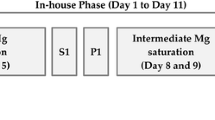Abstract
Chelation therapy and supplemental Cr have both been shown to lead to improved blood glucose, lipids, and insulin activity. Chelation therapy leads to the removal of toxic as well as essential metals. To determine if chelation therapy leads to increased urinary Cr losses and altered Cr homeostasis, 2 groups of subjects (1 group that had undergone only 1 or no chelation therapy and 1 group in which all subjects had undergone at least 19 chelation sessions) were evaluated for differences in possible Cr homeostasis based on urinary Cr losses. There were no significant differences in urinary Cr losses between the two groups of subjects and there were no significant increases in urinary Cr losses resulting from chelation therapy. Increases in urinary Cr losses were strongly influenced by supplementation but not chelation therapy.
Similar content being viewed by others
References
E. M. Cranton and J. P. Frackelton, Free radical pathology in age-associated diseases: treatment with EDTA chelation, nutrition, and antioxidants,J. Adv. Med. 2, 17–54 (1989).
R. A. Anderson, Recent advances in the clinical and biochemical manifestation of chromium deficiency in human and animal nutrition,J. Trace Element Exp. Med. 11, 241–250 (1998).
L. T. Chappell and M. Janson, EDTA chelation therapy in the treatment of vascular disease,J. Cardiovasc. Nutr. 10, 78–86 (1996).
E. M. Cranton, Z. X. Liu, and I. M. Smith, Urinary trace and toxic elements and min- erals in untimed urine specimens relative to urine creatinine, Part I: concentrations of elements in fasting urine,J. Adv. Med. 2, 331–348 (1989).
R. A. Anderson, Stress effects on chromium nutrition of humans and farm animals, inProc. Alltech’s Tenth Symposium Biotechnology in the Feed Industry, Nottingham Uni- versity Press, Loughbrough, England, pp. 267–274 (1994).
R. A. Anderson and A. S. Kozlovsky, Chromium intake, absorption and excretion of subjects consuming self-selected diets,Am. J. Clin. Nutr. 41, 1177–1183 (1985).
R. A. Anderson, N. A. Bryden, and M. M. Polansky, Dietary chromium intake-freely chosen diets, institutional diets and individual foods,Biol. Trace Element Res. 32, 117–121 (1992).
D. W. Cockcroft and M. H. Gault, Prediction of creatinine clearance from serum cre- atinine,Nephron 16, 31–41 (1976).
A. Anderson, M. M. Polansky, N. A. Bryden, K. Y. Patterson, C. Veillon, and W. Glinsmann, Effects of chromium supplementation on urinary Cr excretion of human subjects and correlation of Cr excretion with selected clinical parameters,J. Nutr. 113, 276–281 (1983).
C. Veillon, W. R. Wolf, and B. E. Guthrie, Determination of chromium in biological materials by stable isotope dilution,Anal. Chem. 51, 1022–1024 (1979).
A. Popovici, C. F. Geschichter, A. Reinovsky, and M. Rubin, Experimental control of serum calcium levels in vivo,Proc. Soc. Exp. Biol. Med. 74, 415–422 (1950).
N. E. Clarke, C. N. Clarke, and R. E. Moscher, Treatment of angina pectoris with dis- odium ethylene diamine tetraacetic acid,Am. J. Med. Sci. 4, 654–666 (1956).
S. K. Tandon and J. S. Gaur, Chelation in metal intoxication. IV. Removal of chromium from organs of experimentally poisoned animals,Clin. Toxicol. 11, 257–264 (1977).
W. Banner, Jr., M. Koch, D. M. Capin, S. B. Hopf, S. Chang, and T. G. Tong, Experi- mental chelation therapy in chromium, lead and boron intoxication with N-acetyl- cysteine and other compounds,Toxicol. Appl. Pharmacol. 83, 142–147 (1986).
F. Sata, S. Araki, K. Murata, and H. Aono, Behavior of heavy metals in human urine and blood following calcium disodium ethylenediamine tetraacetate injection: obser- vations in metal workers,J. Toxicol. Environ. Health 54, 167–178 (1988).
R. A. Anderson, N. A. Bryden, M. M. Polansky, and J. W. Thorp, Effect of carbohy- drate loading and underwater exercise on circulating cortisol, insulin and urinary losses of chromium and zinc,Eur. J. Appl. Physiol. 63, 146–150 (1991).
L. S. Goodman and A. Gilman,The Pharmacological Basis of Therapeutics, 3rd ed., MacMillian Co., New York, p. 950 (1985).
Author information
Authors and Affiliations
Rights and permissions
About this article
Cite this article
Anderson, R.A., Bryden, N.A. & Waters, R. EDTA chelation therapy does not selectively increase chromium losses. Biol Trace Elem Res 70, 265–272 (1999). https://doi.org/10.1007/BF02783835
Received:
Accepted:
Issue Date:
DOI: https://doi.org/10.1007/BF02783835




